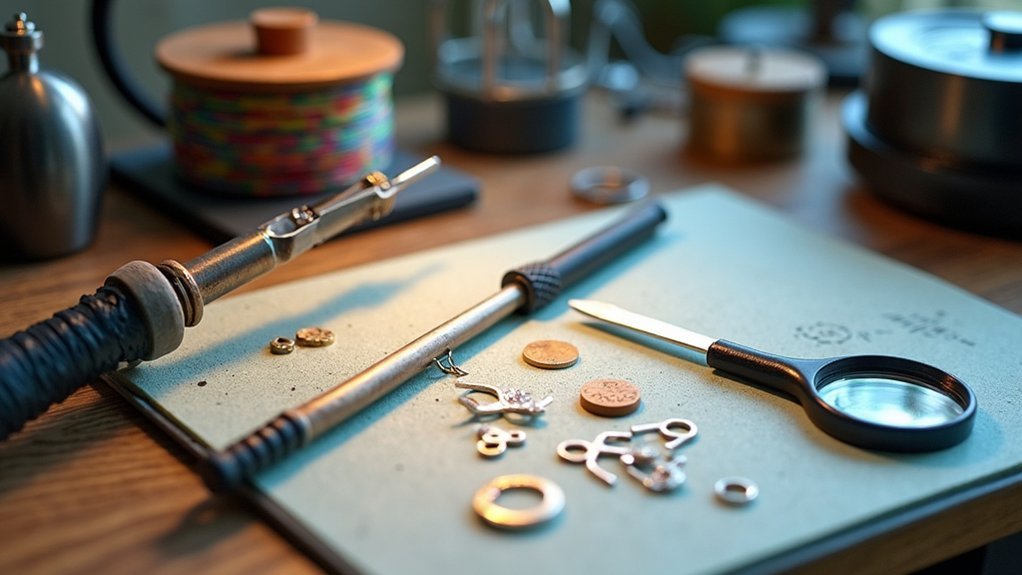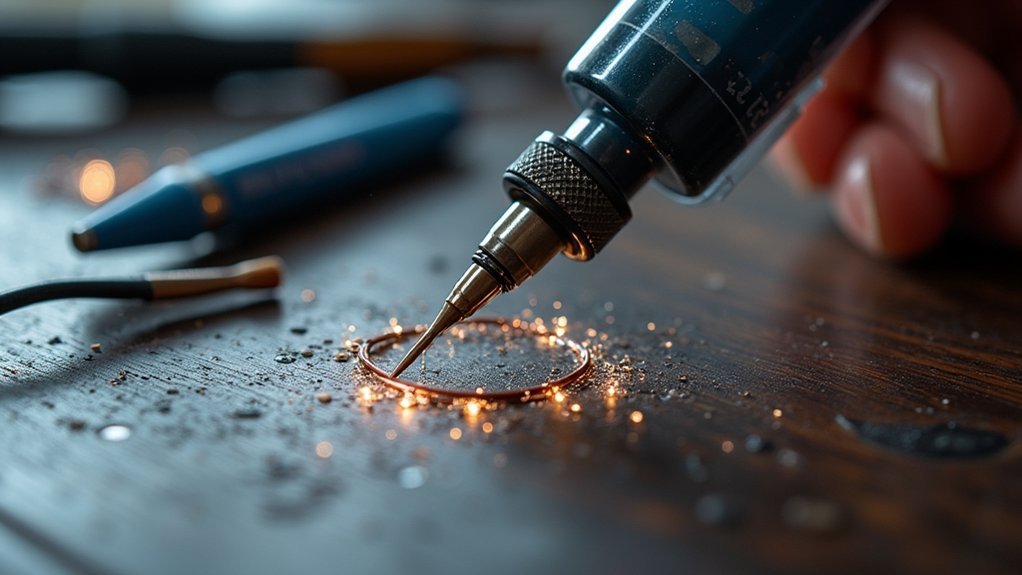You’ll need a temperature-controlled soldering iron with adjustable settings, quality non-lead solder, and flux pens for precise application. Essential tools include precision tweezers, third-hand stabilizers with magnifiers, and component holding fixtures to eliminate hand tremors. Heat sinks protect sensitive pieces while proper ventilation and safety equipment guarantee safe working conditions. Digital calipers verify fit tolerances and magnifying equipment helps inspect joint quality. Mastering these fundamental tools will reveal advanced techniques for professional-grade results.
Essential Soldering Equipment for Jewelry Findings

Five key tools form the foundation of any successful jewelry soldering setup.
You’ll need a quality soldering iron with adjustable temperature settings to control heat application precisely across different materials. Non-lead solder is your best choice for safety and environmental reasons, though it requires careful heat management at its 210°C melting point.
A flux pen like Kester’s no-clean model 951 reduces oxidation and improves solder flow for stronger connections.
You’ll want a soldering grate to apply heat from below while protecting delicate components from overheating.
Finally, third-hand tools such as Aven Tools Helping Hands Magnifier provide the stability and visibility you need for intricate work on jewelry findings.
Specialized Tools for Precise Component Placement
You’ll need specialized tools beyond basic soldering equipment to achieve precise placement of jewelry findings and small components.
Precision tweezers become your primary instrument for handling delicate pieces, while component holding fixtures keep everything stable during the soldering process.
Positioning jigs and guides guarantee you’ll maintain perfect alignment and repeatability across multiple pieces in your jewelry work.
Tweezers for Fine Work
When working with delicate electronic components, precision tweezers become your most trusted allies for achieving accurate placement without causing damage. You’ll want anti-static or ESD-safe tweezers to prevent electrostatic discharge that could harm sensitive parts. Fine-tipped tweezers give you superior control when maneuvering tight spaces on circuit boards.
| Tweezer Type | Best Use Case |
|---|---|
| Straight Fine-Tip | Small component placement |
| Curved/Angled | Hard-to-reach areas |
| Serrated | Gripping textured surfaces |
| Anti-Static | ESD-sensitive components |
| Bent Nose | Angled access points |
Curved or angled tips help you access difficult spots efficiently. Investing in various types—straight, bent, and serrated—covers diverse soldering needs and enhances your overall precision during intricate projects.
Component Holding Fixtures
While precise tweezers excel at component manipulation, component holding fixtures take stability to the next level by securing parts in exact positions during soldering.
These specialized tools eliminate hand tremors and free up both hands for precise work.
Third-hand tools with adjustable arms and alligator clips provide the stable foundation you need for intricate soldering tasks.
The clips securely grip various component shapes and sizes while maintaining exact positioning throughout the process.
Magnifying helping hands combine component stability with enhanced visibility through built-in magnifiers.
This dual functionality guarantees you can see fine details clearly while maintaining steady component placement.
Here are three key benefits of quality component holding fixtures:
- Heat Protection – Integrated heat sinks protect sensitive components from thermal damage
- Adjustable Positioning – Flexible arms accommodate complex component arrangements
- Improved Efficiency – Hands-free operation considerably increases soldering speed and accuracy
Positioning Jigs and Guides
Positioning jigs and guides elevate component holding beyond simple gripping by providing structured frameworks that guarantee perfect placement every time. These specialized tools confirm precise alignment while reducing misplacement risks during soldering operations.
You’ll find adjustable clamps and magnetic bases accommodate various component sizes and shapes, making positioning jigs versatile for different projects.
The hands-free operation these tools provide dramatically improves your efficiency, freeing both hands for soldering tasks. Built-in measuring guides and markings help you maintain consistent spacing and component orientation throughout your work.
Quality jigs deliver cleaner solder joints by minimizing movement and confirming even heat distribution. This investment pays dividends through improved soldering results and professional-grade precision in your finished pieces.
Heat Management and Temperature Control Solutions
Although soldering may seem straightforward, achieving consistent, high-quality joints depends heavily on your ability to control heat and temperature throughout the process. Effective heat management prevents component damage while ensuring proper solder flow and adhesion.
A good soldering station with temperature control is your foundation for success. You’ll want adjustable settings ranging from 200°C to 480°C to accommodate different solder types and component requirements. This precise soldering temperature control dramatically improves joint quality.
Essential heat management tools include:
- Temperature-controlled soldering stations – Maintain consistent heat output for reliable results
- Larger soldering tips – Enhance heat transfer for bigger components without overheating nearby areas
- Heat sinks and copper clips – Protect sensitive components from excessive thermal stress during soldering
Proper ventilation systems also maintain ideal working conditions while protecting your health.
Flux Application Tools and Techniques

You’ll achieve better solder joints when you master flux application tools and their proper techniques.
Flux pens offer pinpoint accuracy for individual connections, while no-clean formulations eliminate tedious cleanup steps that can damage delicate findings.
Understanding when and how much flux to apply prevents oxidation and guarantees smooth, reliable connections every time.
Flux Pen Precision Application
When precision matters most in your soldering work, a flux pen delivers controlled application that transforms the quality of your joints.
You’ll achieve better soldering results by applying flux exactly where it’s needed without creating mess or waste. The targeted tip lets you reach tight spaces on circuit boards while preventing extra flux from contaminating surrounding areas.
Key advantages of flux pen precision application:
- Enhanced joint quality – Proper flux distribution improves solder flow and prevents oxidation for stronger, more reliable connections.
- Reduced cold joints – Consistent surface preparation guarantees ideal solder adhesion every time.
- Professional results – Clean, controlled application eliminates excess residue and delivers consistently superior outcomes.
Kester’s no-clean model 951 Flux-Pen stands out as the top choice for both beginners and experienced soldering enthusiasts.
No-Clean Flux Benefits
No-clean flux revolutionizes your soldering workflow by eliminating the tedious cleaning step that traditional flux requires.
You’ll save time and achieve cleaner results without worrying about residue contaminating your work. When you apply flux before soldering, it reduces oxidation on metal surfaces, ensuring stronger adhesion and better conductivity for each solder joint.
This no-clean flux handles higher temperatures effectively, making it perfect for lead-free applications that demand elevated melting points.
You can control application precisely using flux pens or brushes, ensuring uniform coverage without excess that causes pooling. The minimal residue left behind won’t interfere with your circuit’s performance, and you won’t need additional cleaning supplies or time-consuming post-solder cleanup processes.
Proper Flux Timing
Although many beginners rush through flux application, timing determines the success of your solder joints more than any other factor.
You’ll achieve ideal results by applying flux immediately before heating, ensuring maximum adhesion and superior heat transfer. This soldering technique prevents oxidation that occurs when flux sits too long on metal surfaces.
Your flux application strategy should follow these critical steps:
- Apply flux just before soldering – Never flux components hours or even minutes in advance, as oxidation will compromise joint quality.
- Use controlled amounts – Flux pens provide precise application without excess that creates messy joints.
- Work systematically – For larger surfaces, brush flux evenly across the entire area for complete coverage.
Safety Equipment and Workspace Setup

Five essential safety measures will protect you and your workspace during soldering operations. You’ll need safety glasses to shield your eyes from solder splashes and toxic fumes. Keep your workspace well-ventilated by opening windows or using a fume extractor to minimize exposure to hazardous smoke. Place a heat-resistant mat under your work area to prevent burns and surface damage from your soldering iron.
| Safety Equipment | Purpose |
|---|---|
| Safety glasses | Eye protection from splashes/fumes |
| Mask/respirator | Minimize fume inhalation |
| Fire extinguisher | Emergency electrical fire response |
| Heat-resistant mat | Workspace protection |
| Fume extractor | Improve air circulation |
Keep a fire extinguisher rated for electrical fires within reach. Organize your tools efficiently to maintain clean workspace conditions and reduce accident risks.
Quality Assessment and Finishing Tools
After completing your solder joints, you’ll need specialized tools to assess quality and achieve professional-looking finishes. Your soldering station’s performance depends on maintaining clean equipment and proper finishing techniques.
Use flux appropriately during the process, then clean the tip regularly to guarantee consistent results.
Essential quality assessment and finishing tools include:
- Magnifying equipment with LED lighting – Provides clear visibility to inspect joint integrity, identify cold solder connections, and spot potential defects that could compromise structural strength.
- Cleaning brushes and polishing compounds – Remove flux residue, oxidation, and surface imperfections while restoring the natural luster of your soldered findings without damaging delicate details.
- Digital calipers and measurement tools – Verify dimensional accuracy, assure proper fit tolerances, and confirm that your soldered components meet precise specifications for professional-quality results.
Frequently Asked Questions
How Can I Make Soldering Easier?
You’ll make soldering easier by investing in a quality temperature-controlled station, using flux pens for better flow, employing third-hand tools for positioning, and keeping your workspace clean and organized.
Why Does Flux Make Soldering Easier?
Flux removes oxidation from metal surfaces and lowers solder’s surface tension, so you’ll get better flow and stronger joints. It prevents cold connections by ensuring your metals are properly cleaned before soldering.
What Is the Secret to Good Soldering?
You’ll master soldering by keeping your iron tip clean, using fresh solder with flux, preparing joints properly without gaps, heating surfaces adequately before applying solder, and practicing regularly with patience.
What Is the Number One Rule of Soldering?
You’ll achieve the best soldering results by keeping all components absolutely clean and properly prepared. Dirt, oils, or oxidation will prevent solder from flowing correctly and create weak, unreliable joints.
In Summary
You’ll find that investing in quality soldering tools transforms your jewelry-making experience. The right temperature-controlled iron, precision tweezers, and proper flux applicators make accurate placement effortless. Don’t overlook safety equipment and workspace organization—they’re just as essential for consistent results. With practice and the proper tools, you’ll achieve professional-quality solder joints that enhance your jewelry’s durability and appearance. Your findings will look cleaner, stronger, and more refined.





Leave a Reply